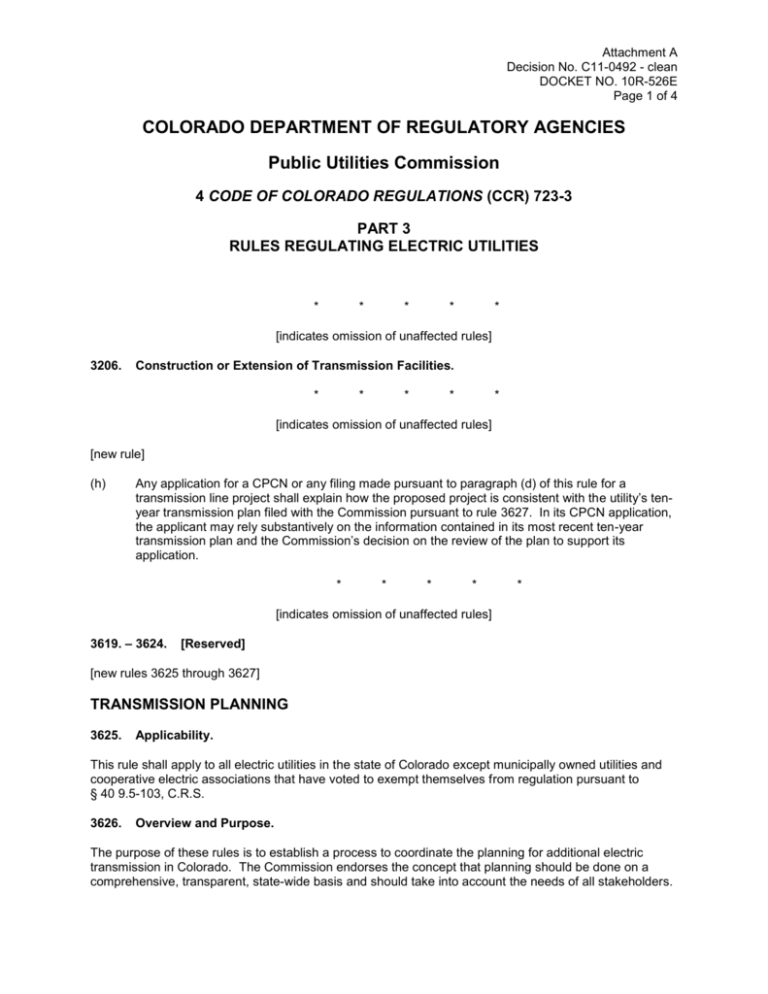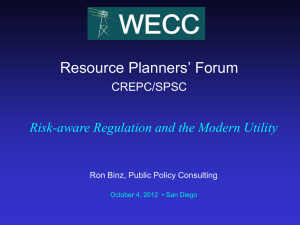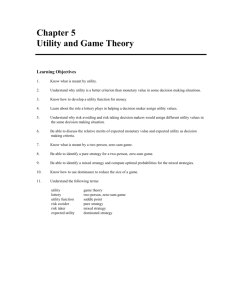AdoptedRules02010-00747 - Colorado Secretary of State
advertisement

Attachment A Decision No. C11-0492 - clean DOCKET NO. 10R-526E Page 1 of 4 COLORADO DEPARTMENT OF REGULATORY AGENCIES Public Utilities Commission 4 CODE OF COLORADO REGULATIONS (CCR) 723-3 PART 3 RULES REGULATING ELECTRIC UTILITIES * * * * * [indicates omission of unaffected rules] 3206. Construction or Extension of Transmission Facilities. * * * * * [indicates omission of unaffected rules] [new rule] (h) Any application for a CPCN or any filing made pursuant to paragraph (d) of this rule for a transmission line project shall explain how the proposed project is consistent with the utility’s tenyear transmission plan filed with the Commission pursuant to rule 3627. In its CPCN application, the applicant may rely substantively on the information contained in its most recent ten-year transmission plan and the Commission’s decision on the review of the plan to support its application. * * * * * [indicates omission of unaffected rules] 3619. – 3624. [Reserved] [new rules 3625 through 3627] TRANSMISSION PLANNING 3625. Applicability. This rule shall apply to all electric utilities in the state of Colorado except municipally owned utilities and cooperative electric associations that have voted to exempt themselves from regulation pursuant to § 40 9.5-103, C.R.S. 3626. Overview and Purpose. The purpose of these rules is to establish a process to coordinate the planning for additional electric transmission in Colorado. The Commission endorses the concept that planning should be done on a comprehensive, transparent, state-wide basis and should take into account the needs of all stakeholders. Attachment A Decision No. C11-0492_clean DOCKET NO. 10R-526E Page 2 of 4 3627. Transmission Planning. (a) No later than February 1, 2012 and February 1 of each even year thereafter, each electric utility shall file a ten-year transmission plan and supporting documentation pursuant to this rule. (I) (b) (c) Each ten-year transmission plan shall meet the following goals: (A) The proposed projects do not negatively impact the system of any other transmission provider or the overall transmission system in the near-term and long-term planning horizons; (B) The proposed projects avoid duplication of facilities; (C) The proposed projects reflect the development of joint projects where a proposed project services the mutual needs of more than one transmission provider and/or stakeholder; and (D) The proposed projects are coordinated with all transmission providers in Colorado. (II) The plan shall identify all proposed facilities 100kV or greater. (III) If any of the information required to be filed pursuant to this rule is available on a utility or utility maintained website, then it is sufficient for purposes of this rule to include in the filing a web address that provides direct access to that specific piece of information. This address must remain active until the next biennial filing. Each ten-year transmission plan shall demonstrate compliance with the following requirements: (I) The efficient utilization of the transmission system on a best-cost basis, considering both the short-term and long-term needs of the system. The best-cost is defined as balancing cost, risk and uncertainty and includes proper consideration of societal and environmental concerns, operational and maintenance requirements, consistency with short-term and long-term planning opportunities, and initial construction cost. (II) All applicable reliability criteria for selected demand levels over a range of forecast system demands, including summer peak load, winter peak load and reduced load when renewable generation is maximized. (III) All legal and regulatory requirements, including renewable energy portfolio standards and resource adequacy requirements. (IV) Consistency with applicable transmission planning requirements in the Federal Energy Regulatory Commission (FERC) Order 890. Each ten-year transmission plan shall contain the following information: (I) The methodology, criteria and assumptions used to develop the transmission plan. This includes the transmission facility rating methodology and established facility ratings; transmission base case data for all applicable power flows, short circuit and transient stability analyses; and utility specific reliability criteria. Attachment A Decision No. C11-0492 - clean DOCKET NO. 10R-526E Page 3 of 4 (II) The load forecasts, load forecast reductions arising from net metered distributed generation and utility sponsored energy efficiency programs, and controllable demand side management data including the interruptible demands and direct load control management used to develop the transmission plan. (III) The generation assumptions and data used to develop the transmission plan. (IV) The methodology used to determine system operating limits, transfer capabilities, capacity benefit margin, and transmission reliability margin, with supporting data and corresponding established values. (V) The status of upgrades identified in the transmission plan, as well as changes, additions or deletions in the current plan when compared with the prior plan. (VI) The related studies and reports for each new transmission facility identified in the transmission plan including alternatives considered and the rationale for choosing the preferred alternative. The depth of the studies, reports, and consideration of alternatives shall be commensurate with the nature and timing of the new transmission facility. (VII) The expected in-service date for the facilities identified in the transmission plan and the entities responsible for constructing and financing each facility. (VIII) A summary of stakeholder participation and input and how this input was incorporated in the transmission plan. (d) No later than February 1, 2012 and February 1 of each even year thereafter, each utility shall file all economic studies performed pursuant to FERC Order 890 since the last biennial filing. Such studies generally evaluate whether transmission upgrades or other investments can reduce the overall costs of serving native load. These studies are conducted for the purpose of planning for the alleviation of transmission bottlenecks or expanding the transmission system in a manner that can benefit large numbers of customers, such as the evaluation of transmission upgrades or additions necessary to build or acquire new generation resources. The report shall identify who requested the economic study and shall identify all economic studies requested but not performed. (e) No later than February 1, 2014 and February 1 of each even year thereafter, each utility shall file conceptual long-range scenarios that look 20 years into the future. These conceptual long-range scenarios shall analyze projected system needs for various credible alternatives, including, at a minimum, the following: (f) (I) Reasonably foreseeable future public policy initiatives; (II) Possible retirement of existing generation due to age, environmental regulations or economic considerations; (III) Emerging generation, transmission and demand limiting technologies; (IV) Various load growth projections; and (V) Studies of any scenarios requested by the Commission in the previous biennial review process. Amended filings made pursuant to this rule are permitted at any time for good cause shown. Attachment A Decision No. C11-0492_clean DOCKET NO. 10R-526E Page 4 of 4 (g) Government agencies and other stakeholders shall have an opportunity for meaningful participation in the planning process. (I) Government agencies include affected federal, state, municipal and county agencies. Other stakeholders include organizations and individuals representing various interests that have indicated a desire to participate in the planning process. (II) During the development of the ten-year transmission plan when objectives and needs are being identified, each utility shall actively solicit input from the appropriate government agencies and stakeholders to identify alternative solutions. (III) Once a utility has evaluated the alternative solutions and has prepared recommendations for inclusion in its ten-year transmission plan, the utility shall notify the government agencies and stakeholders of these recommendations. (IV) The outreach anticipated in subparagraphs (g)(II) and (g)(III) shall occur in a timely manner prior to the filing of the ten-year plans. (V) Each utility shall concurrently provide copies of the filings made pursuant to this rule to all government agencies and other stakeholders that participate in the planning process. (h) After the ten-year transmission plans have been filed by utilities, the Commission will consolidate the plans in one proceeding. In this proceeding, the Commission will solicit written comments and will hold a workshop(s) and/or a hearing(s) on the plans for the purpose of reviewing and rendering a decision regarding the adequacy of the utilities’ filed transmission plans and process used in formulating the plans. The Commission, on its own motion or at the request of others, may request additional supporting information from the utilities or the commenters. The Commission will review the plans and supporting information, the written comments, and the information obtained at the workshop(s) or hearing(s), and will issue a written decision regarding compliance with these rules and the adequacy of the existing and planned transmission facilities in this state to meet the present and future energy needs in a reliable manner. In this decision, the Commission may also provide further guidance to be used in the preparation of the next biennial filing. (i) Utilities shall make reference to the most recently filed ten-year transmission plan in any subsequent CPCN application for individual projects contained in that plan. Given sufficient documentation in the biennial ten-year transmission plan for the project under review and if circumstances for the project have not changed, the applicant may rely substantively on the information contained in the plan and the Commission’s decision on the review of the plan to support its application. The Commission will take administrative notice of its decision on the plan. Any party challenging the need for the requested transmission project has the burden of proving that, due to a change in circumstances, the Commission’s decision is no longer applicable or valid. 3628. – 3649. [Reserved] * * * * * [indicates omission of unaffected rules]






